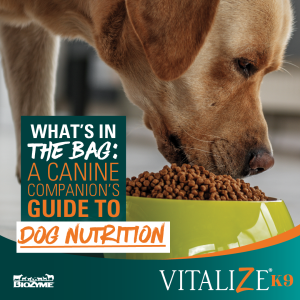
Stress. What stress?! When it comes to our day-to-day, people are pretty accustomed to being stressed out, even if just a little bit. When it comes to our fur babies and four-legged best friends, though, we don’t want stress to even be a part of their vocabulary. The goal is that they have everything they need–food, water, naps, walks, and, in some households, a never-ending game of fetch. However, dog anxiety is a real concern, and nobody likes seeing their best friend under stress.
At BioZyme®, care that comes full circle is at the heart of everything we do. That means providing our furry friends the best life possible. And since the Vitalize® Team is a bunch of canine fanatics; we want to help! That’s why we’ve made this blog: to help identify the critical signs of stress in dogs so you can give your pups the TLC they need.
10 Criticals Signs of Stress in Dogs
Just like humans, stress in dogs can manifest in various ways, often through changes in behavior or physical symptoms. There are several causes for dog anxiety, including and not limited to phobias, past traumatic situations or changes in environment or situation.
Recognizing the critical signs of stress in dogs can help you address the underlying causes and take steps to reduce their stress.
Here are 10 key signs to watch for:
1. Excessive Panting or Drooling
While panting is normal for dogs to regulate body temperature, excessive panting without apparent cause could indicate stress or anxiety. Excessive drooling can also be a sign of stress. This is a stress response to perceived threats, fear-inducing stimuli or unfamiliar situations. When dogs feel anxious or stressed, their bodies may release stress hormones such as cortisol, which can trigger physiological changes, including increased respiratory rate (panting) and salivation (drooling).
2. Restlessness
A stressed dog may have difficulty settling down, pacing back and forth or moving around more than usual. They will appear restless, unable to settle down or relax. Stressed dogs struggle to relax or find a comfortable resting position, even when they are physically tired. They may appear fidgety, constantly shifting positions and unable to settle down for extended periods. Restlessness may persist even during quiet moments or when the dog is alone.
3. Shaking or Trembling
Dogs may shake or tremble when they’re stressed or anxious. This can be due to fear, nervousness, or discomfort. Dogs may tremble or shake involuntarily, especially in situations that trigger fear or anxiety. Just like humans that are anxious or nervous, shake, so do dogs. This is a natural response to anxious behavior.
4. Destructive Behavior
Stress can lead to destructive actions like chewing, digging or scratching inappropriately. These behaviors are often a sign of underlying stress or anxiety. If they are suddenly destroying chew toys, shoes or pillows that they normally would not, something is likely causing them stress. Destructive behavior is to dogs as stress eating might be to a human; they just don’t think about what they are doing.
5. Aggression or Irritability
A typically friendly dog may become aggressive, growl, snap or bark excessively when stressed. This can be a response to feeling threatened or uncomfortable. If your normally calm dog is being aggressive or causing you to be afraid, it could be experiencing stress from another person or animal. Pay attention to what it is showing aggression toward.
6. Withdrawal or Avoidance
A stressed dog may withdraw from social interactions, hiding or avoiding contact with people or other animals. They might attempt to hide behind furniture, under beds or in closets. Alternatively, they may seek comfort and reassurance from their owners or other familiar individuals. They’re looking for a safe space.
7. Excessive Barking or Whining
Your stressed dog is talking to you. Listen up. Increased vocalization, such as barking or whining, can be a sign of stress. It might indicate discomfort, fear or simply a need for reassurance. Barking and whining are natural forms of communication for dogs, and anxious dogs may vocalize to express their feelings of fear, unease or discomfort. Barking and whining can serve as signals to alert their owners or other animals to their emotional state and the presence of potential threats or stressors.
8. Changes in Appetite or Eating Habits
Stress can cause a dog to lose interest in food or overeat as a coping mechanism. If a loss of appetite persists or leads to other health concerns, consult your veterinarian sooner rather than later.
9. Changes in Bathroom Habits
A stressed dog may start having accidents in the house or urinate or defecate inappropriately. This is one of the best ways your dog knows to get your attention. They are trying to communicate to you that they are anxious about something, probably something outside or out of their control. No one enjoys cleaning up the accidents, but don’t discipline your dog. He or she is trying to tell you something.
10. Ears Back or Tail Tucked
If you’ve seen your dog with its tail between its legs or its ears pinned back, you know this is a sign of stress or discomfort. These are common body language signs indicating a dog is feeling stressed, scared or submissive. Try to pinpoint what is bothering your dog and eliminate it from the situation.
Recognizing these critical signs of stress in dogs is the first step in addressing dog discomfort or stress. If you notice any of these behaviors in your dog, try to identify the source of stress and work to eliminate or reduce it. It may also be helpful to create a calm and safe environment, provide plenty of exercise and mental stimulation. Finally, consider consulting with a veterinarian for additional guidance and support, especially if any of these signs persist or more than one of them exists.
Vitalize Can Help
Vitalize products come in various forms including liquid, gel and powder. The quick-response product we recommend to help with dog stress is Vitalize® Dog Gel.
Vitalize Dog Gel is a prebiotic and nutrient-rich gel for dogs. It immediately supports the digestive and immune systems. It contains AO-Biotics® Amaferm® and MOS to help normalize gut microflora and the immune system. The Gel works fast to support appetite and hydration.
Get your Vitalize Today!
Help your dog stay healthy and stress-free by grabbing them some Vitalize today. We have made purchasing Vitalize products as easy as possible.
You can visit your local dealer to purchase Vitalize products. Locate a dealer near you, today.
Perhaps you prefer the convenience of online shopping. Well, you can shop online or visit one of our authorized online retail partners and have the Vitalize delivered right to your front door.
Sign Up for Our Newsletter
Want to learn more about other ways to take care of your furry friends? Visit the Vitalize blog today and sign up for our electronic newsletter.

